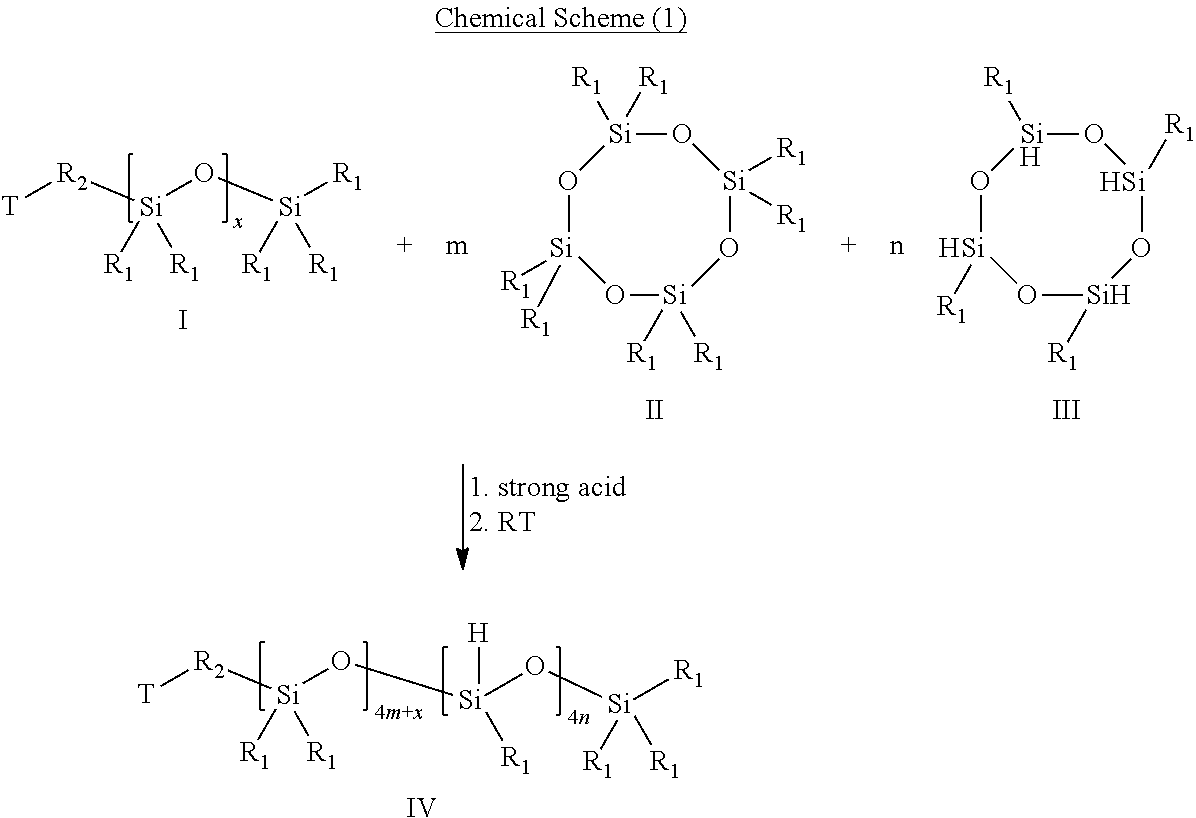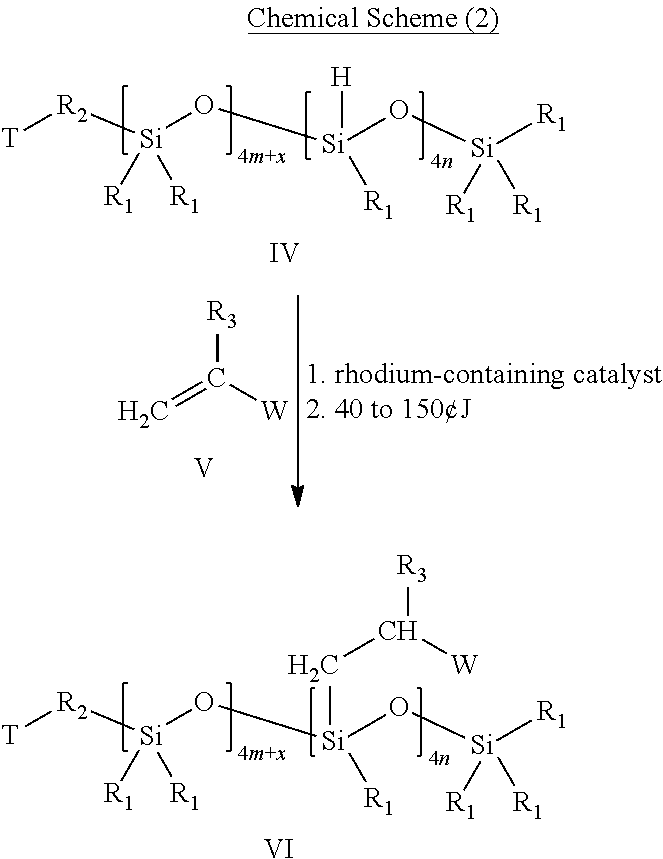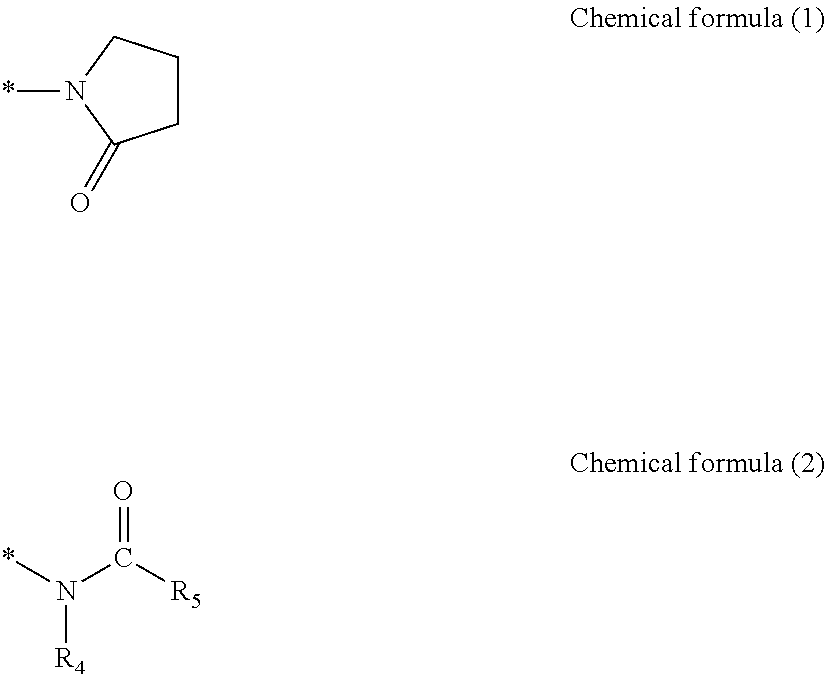Method for manufacturing hydrophilic silicone macromer
a silicone macromer and hydrophilic silicone technology, applied in the field of contact lens materials, can solve the problems of silicone hydrogel lens wettability, no effective method for manufacturing a hydrophilic silicone macromer has ever been disclosed, especially for those containing amide or phosphoryl choline hydrophilic side chains, etc., to achieve better catalytic effect, poor catalytic effect, and improved wettability of polysiloxane intermediate vi
- Summary
- Abstract
- Description
- Claims
- Application Information
AI Technical Summary
Benefits of technology
Problems solved by technology
Method used
Image
Examples
embodiments
[0041]The following examples are provided to illustrate certain aspects of the present disclosure and to aid those of skill in the art in practicing this disclosure. These examples are in no way to be considered to limit the scope of the disclosure in any manner.
example 1
Preparation of Macromer 1 Having Side Chain with Pyrrolidone Group
Ring-Opening Insertion
[0042]29.6 g (0.1 mole) 1,3,3,5,5,7,7-octamethylcyclotetrasiloxane, 24.0 g (0.1 mole) 1,3,5,7-tetramethyl-cyclotetrasiloxane, 93.5 g (0.1 mole) butyl [(hydroxyethoxy)propyl]polydimethylsiloxane and 1.2 mg trifluoromethanesulfonic acid were putted into a 1-L-3-necked round bottom flask equipped with a reflux condenser and a nitrogen blanket. The molar ratio of 1,3,3,5,5,7,7-octamethylcyclotetrasiloxane, 1,3,5,7-tetramethyl-cyclotetrasiloxane and butyl[(hydroxyethoxy)propyl]polydimethylsiloxane is 1:1:1. The mixture was stirred for 24 hours at 25° C., and a solution is then formed.
[0043]Next, reactive hydrogen terminated-polysiloxane having Si—H bonds was obtained after extracting the solution for several times. For instance, a first extraction step was performed. 200 ml ether and 350 ml water were added into the solution, and the aqueous layer was then removed. The organic layer was washed twice w...
example 2
Preparation of Contact Lens
[0050]The hydrophilic silicone macromer, N-vinylpyrrolidone, 2-hydroxyethyl methacrylate, isobornyl methacrylate, ethylene glycol dimethacrylate, triallylisocyanurate, t-amyl alcohol and azo bis isobutyl nitrile were mixed in a weight ratio of 65:30:5:5:0.2:0.3:10:1. Next, the mixture was filtered by a 0.5 μm filter and then filled into a polypropylene mold. Next, the hydrophilic polymer was cured under the condition of 55° C. / 1.5 hr, 70° C. / 0.5 hr, 90° C. / 0.5 hr, 110° C. / 0.5 hr in sequence and then cooled to an ambient temperature. The lenses were released and extracted with isopropanol for 4 hours. The lenses were dipped into 50 / 50 isopropanol / water for 30 minutes, and then dipped into distilled water for 30 minutes. Next, the lenses were placed into a glass vial filled with borate-containing physiological saline buffer solution and autoclaved at 121° C. for 30 minutes. The water content of the lenses was 58.1%.
PUM
| Property | Measurement | Unit |
|---|---|---|
| molecular weight | aaaaa | aaaaa |
| transparent | aaaaa | aaaaa |
| water content | aaaaa | aaaaa |
Abstract
Description
Claims
Application Information
 Login to View More
Login to View More - R&D
- Intellectual Property
- Life Sciences
- Materials
- Tech Scout
- Unparalleled Data Quality
- Higher Quality Content
- 60% Fewer Hallucinations
Browse by: Latest US Patents, China's latest patents, Technical Efficacy Thesaurus, Application Domain, Technology Topic, Popular Technical Reports.
© 2025 PatSnap. All rights reserved.Legal|Privacy policy|Modern Slavery Act Transparency Statement|Sitemap|About US| Contact US: help@patsnap.com



